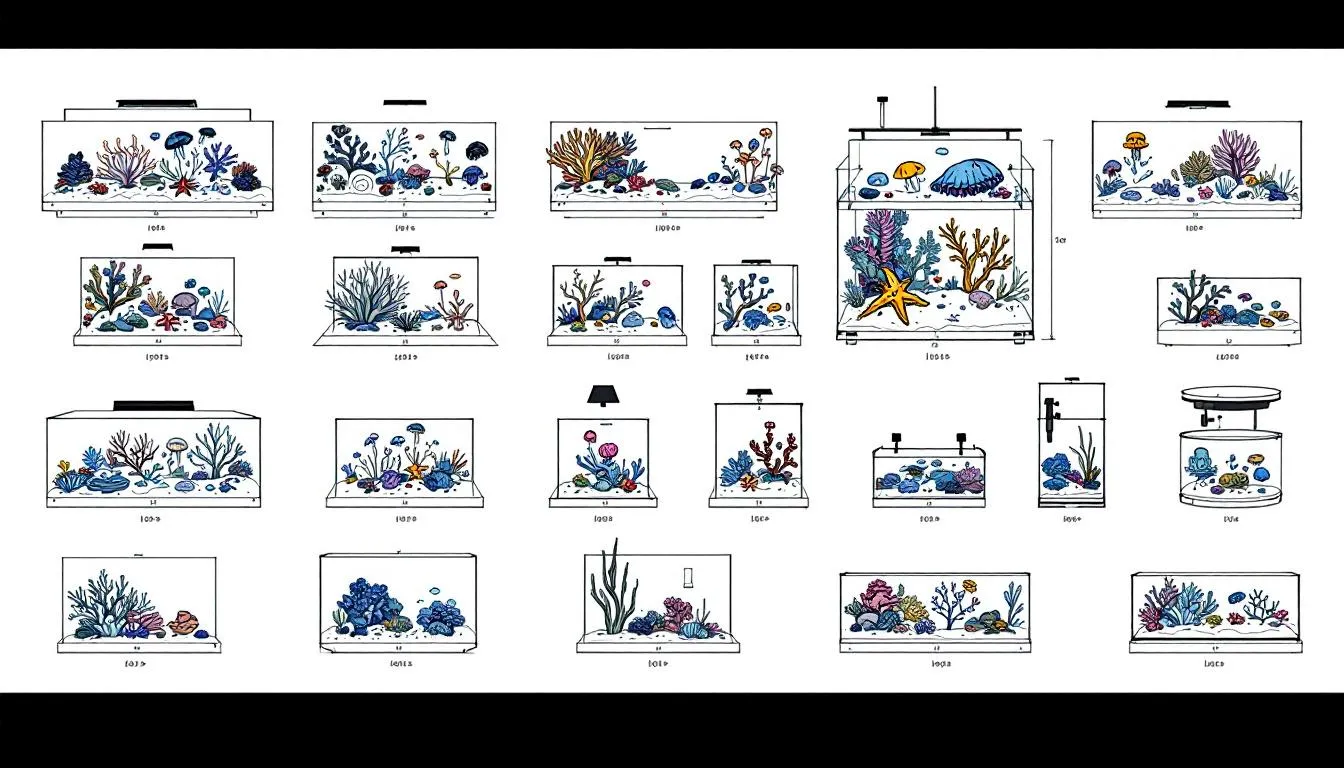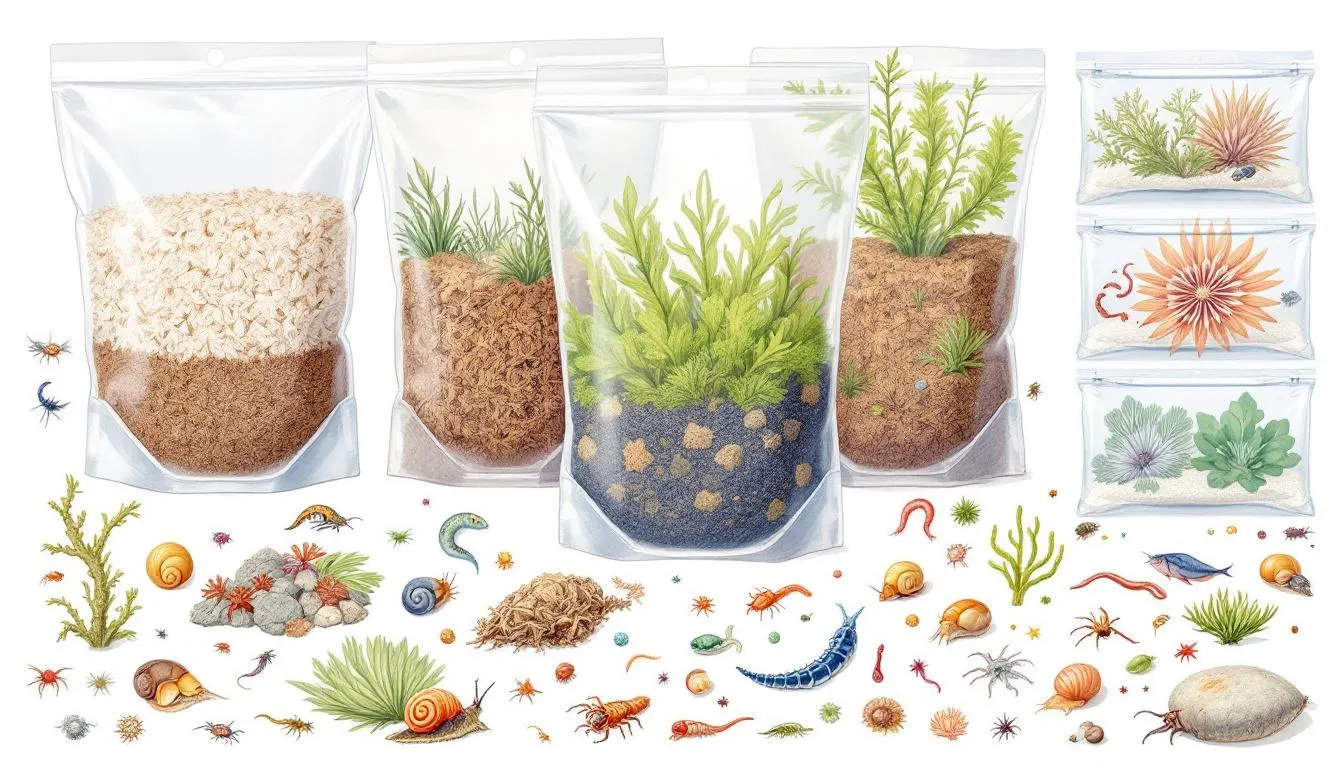Top Invertebrate Supplies: Essential Enclosures, Food, and Care Tips
Need invertebrate supplies to ensure your pets thrive? This guide covers all the essentials, from enclosures and substrates to food and decor. Discover how to create a healthy, stimulating environment for your invertebrates, enhancing their well-being and longevity.
Key Takeaways
-
Choosing the right enclosure and substrate is vital for the health and well-being of invertebrate pets, considering their specific habitat requirements.
-
A varied and balanced diet comprising live insects, commercial diets, and vegetables is essential to maintain the health and longevity of invertebrates.
-
Regular updates on stock and subscription services for supplies enhance the care of invertebrates, ensuring a convenient and diverse experience for pet owners.
Essential Invertebrate Enclosures

Selecting an appropriate enclosure is fundamental for your invertebrate pets’ well-being. Various enclosures, such as glass and acrylic, cater to different needs. Glass enclosures offer durability and clear viewing, whereas acrylic ones are lighter and more manageable. The specific needs of the species you are housing should guide your choice.
Terrestrial and arboreal designs cater to the unique habitat needs of different invertebrate species. For instance, tarantulas that dwell on the ground would benefit from a terrestrial enclosure, while those that climb would thrive in an arboreal setup. The enclosure size should allow your pets to move comfortably. Proper ventilation prevents humidity buildup, which is vital for some species.
High-quality handmade enclosures can greatly improve your invertebrates’ welfare. Tailored enclosures ensure optimal living conditions, keeping your pets healthy and stress-free. Remember, a well-chosen enclosure is not just a home for your pets but a cornerstone of their well-being.
Quality Substrates for Your Pets

Substrates play a vital role in maintaining a healthy environment for your invertebrates. Common substrate types include:
-
Coconut fiber: retains moisture well and provides a naturalistic appearance.
-
Sand
-
Specialized soil mixes Each type offers benefits, and the choice should reflect your pets’ specific needs.
Combining substrates can enhance their properties:
-
A mix of coconut fiber with sand or peat moss creates a versatile environment for various species.
-
Bioactive substrates enhance the enclosure’s aesthetic and promote a healthier environment through beneficial microbial activity.
-
This reduces the need for frequent substrate changes, making maintenance easier and more sustainable.
The right substrate greatly impacts your invertebrates’ health and comfort. It maintains proper humidity levels and provides a medium for natural behaviors like burrowing. Select high-quality products to provide the best care for your pets.
Must-Have Decor and Accessories
Decor and accessories create a stimulating and natural environment for your invertebrates, beyond just enhancing the enclosure’s appearance. Wood, moss, and stones mimic natural habitats, offering hiding spots and climbing structures. These elements reduce stress and encourage natural behaviors, essential for your pets’ well-being.
Cork bark and climbing structures benefit species that enjoy exploring and climbing. These items enhance visual appeal and provide a more engaging environment. Leaf litter and natural debris offer protection and resources for ground-dwelling species, creating a dynamic habitat.
Natural features like rocks and logs provide essential refuges and breeding grounds. Replicate your pets’ natural environment when setting up the enclosure. This not only makes the enclosure more appealing but also ensures your invertebrates feel at home.
Feeding Your Invertebrates: Food Options
A proper diet is crucial for your invertebrates’ health and longevity. Live insects, rich in protein and gut-loadable, often form a well-rounded diet. Crickets, a common nutritious staple, are easy to care for and maintain.
Commercial diets formulated for invertebrates provide essential vitamins and minerals for balanced nutrition. They are convenient and reliable nutrient sources. Including vegetables provides necessary fiber and hydration. Research and adjust diets according to each species’ specific needs.
Monitor food intake and adjust diets based on your invertebrates’ specific needs and health. A varied and balanced diet keeps your pets healthy and active, ready to display fascinating behaviors.
Creating Micro-Habitats
Micro-habitats within terrariums replicate natural environments, greatly benefiting your invertebrates. Coconut coir, or coco peat, is:
-
Versatile and eco-friendly
-
Suitable for rainforest habitats and as a composting mix
-
Effective at retaining moisture, promoting healthy root development when used as a growing medium.
To create a successful micro-habitat:
-
Layer coconut coir above a drainage mesh to maintain moisture without waterlogging.
-
This setup maintains a conducive environment for plant and invertebrate life.
-
Vary plant height and structure, including leaving dead stems, to create unique micro-climates beneficial for invertebrate nesting.
Using coconut coir and diverse plant life fosters a nurturing and diverse environment. Micro-habitats enhance terrarium aesthetics and contribute to your pets’ health and well-being.
Weekly Stock Add Updates
Weekly stock updates keep your collection fresh and exciting. New invertebrate species are added weekly, ensuring a diverse selection. Jumping spiders, mantises, or millipedes, the variety will enhance your collection.
Check back frequently to discover new species and unique offerings. A constant influx of new stock keeps the hobby dynamic, allowing exploration of different species and their care requirements. Imagine the thrill of adding a rare species to your collection, being among the first to acquire it!
Discovering new invertebrates adds to the joy of keeping these fascinating pets. Regular updates ensure access to the latest information and most interesting species.
Rare and Unique Species
Rare and unique invertebrate species hold immense appeal for collectors and enthusiasts. The inventory features both common and rare, hard-to-find species. The Emerald Cockroach (Pseudoglomeris magnifica) is a visually striking species sought by collectors.
The Pink Dragon Millipede, with its vibrant coloration and spine-like features, is highly desirable. Exotic species like the Rainbow Stag Beetle (Phalacrognathus muelleri) and the Giant Flower Beetle (Mecynorrhina ugandensis) capture the interest of unique pet seekers. Collectors value these species for their distinctive appearances and limited availability.
A range of rare and unique species adds diversity and offers learning opportunities about fascinating invertebrates. These species exemplify the incredible biodiversity of the invertebrate world.
Subscription Services for Regular Supplies
Subscription services for feeder bugs and supplies offer several benefits:
-
Ensure your invertebrates are well-fed and cared for conveniently.
-
Provide monthly deliveries, eliminating the need for pet store trips.
-
Stabilize supply and quality, unlike one-time purchases.
Benefits of subscriptions for feeder bugs include:
-
Guarantee of live delivery, reducing stress over product viability.
-
Saving time on frequent shopping trips, providing convenience.
-
Allowing order customization, enabling choice of specific quantities and types of feeder bugs.
-
Consistently meeting your invertebrates’ needs through customization.
Subscription services offer several advantages:
-
They can reduce costs over time compared to individual purchases.
-
Long-term commitments often come with discounts, enhancing financial savings.
-
They provide access to exclusive products or species not available for one-time purchases.
Overall, subscription services offer a hassle-free, cost-effective solution for maintaining a steady supply of quality invertebrate care products.
Caring for Your Invertebrate Pets
Caring for invertebrates like jumping spiders, tarantulas, and snails requires attention to their specific needs. Basic care requirements include a suitable terrarium, hiding spots, and a shallow water dish. Multiple hiding places within the enclosure reduce stress and provide security.
Seed pods in a micro-habitat offer essential nutrition and shelter for various species. Subscription services establish consistent feeding schedules, promoting healthier digestive patterns. Subscriptions ensure pet owners don’t forget to feed their pets, with food arriving on schedule.
Captive-bred invertebrates often maintain better health and longevity than wild-caught specimens. Professional husbandry guidance helps hobbyists make informed decisions about supplies and care. Focusing on these care aspects ensures your invertebrate pets live healthy, fulfilling lives.
Choosing the Right Products
Selecting the right products for your invertebrates is crucial for an optimal environment. Terrariums and aquariums are common enclosures used for housing invertebrates effectively. The focus of the supplies offered for invertebrate care is on creating optimal environments for health and well-being.
Invertebrate supplies should be tailored to the specific needs of each species, including space, humidity, and diet requirements. For example, a bigger enclosure may be necessary for larger species or those that require more space to move around. Selecting the right product means considering all aspects of the invertebrate’s habitat and ensuring it meets their specific needs.
By choosing high-quality products tailored to the needs of your invertebrates, you can create a thriving environment that promotes their health and happiness. This attention to detail ensures that your pets receive the best care possible.
Summary
Summarize the key points discussed in the blog post. Emphasize the importance of choosing the right enclosures, substrates, decor, and food options. Highlight the benefits of creating micro-habitats and the convenience of subscription services. End with an inspiring note encouraging readers to apply their newfound knowledge to enhance their invertebrate care practices.
Frequently Asked Questions
What are the best types of enclosures for invertebrates?
The best types of enclosures for invertebrates are glass and acrylic, as they offer durability and can be specifically designed for various species. Such enclosures provide an ideal environment for the needs of invertebrates.
How can I create a healthy substrate for my invertebrates?
To create a healthy substrate for your invertebrates, combine coconut fiber with sand or peat moss, and consider using bioactive substrates. This combination will promote a suitable habitat for their well-being.
What decor items are essential for an invertebrate enclosure?
Natural decor items, including wood, moss, stones, cork bark, and climbing structures, are essential for creating a stimulating habitat in an invertebrate enclosure. These elements provide enrichment and promote the well-being of the animals.
What should I feed my invertebrates?
A well-rounded diet for your invertebrates should consist of live insects, commercial diets, and vegetables, carefully tailored to their specific species requirements. Ensure you research the dietary needs of your particular invertebrate to provide optimal nutrition.
How often should I update my invertebrate collection?
To maintain a diverse and dynamic invertebrate collection, it is recommended to update your stock weekly, introducing new species regularly. Consistent updates will keep the collection fresh and engaging.









